Mathematical
Tourist Index
Our Calculus
Heritage
|
|
|
A
Primer on Early Calculus
L'Hospital
From the Preface
of his 1696 volume of "Analyse
des infiniment petits Pour l'intelligence des lignes courbes" and
its 1730 English translation:
"I
must own my self very much obliged to the Labours of Messieurs
Bernoulli, but particularly to those of the present Professor at
Groenengen, as having made free with their Discoveries as well as those
of Mr. Leibnitz (sic): So that whatever they please
to claim as their own, I frankly return them."
Guillaume François Antoine, Marquis de l'Hôpital (1661
– 1704)
So what is l'Hospital's written explanation of what today we call his
"Rule"?
He writes, "the infinitely small part by which a quantity is
continually increased or diminished, called the Difference be
considered as the assemblage of an infinity of straight lines, each
infinitely small, or as a polygon having an infinite number of sides."
Today we denote the "Difference"
of an x quantity
by dx. Clearly
l'Hospital considers a segment of a line as part of the curve.
Thus, we encounter the concept of a curve, the concept of
tangent, the concept of slope and the problem of what method to use
when handling indeterminate forms, i.e., 0/0 and ∞/∞.
While we call his method l'Hospital's
Rule, l'Hospital
himself only used the word "rule" for his first five
propositions. Moreover, all of these propositions were
based
on Leibniz's six brief pages published in Acta
Eruditorum, (1684, pp. 467-473). The French word "regles"
appears on the frontispiece (see the background below and to the right)
and on five
propositions, none of which treat the indeterminate form.
Expanding the usage of the word "regles", i.e., rule, appears to be a
much later attachment to his name. Yes, we in mathematics like to
name problems, propositions, theorems, etc. with a person's name.
But seldom is this initiated by the individual himself. After
all, modesty and decorum are at stake.
So where does the indeterminant
form first appear? For clarity, we turn to the 1730 translation.
On page 191 of Section IX, l'Hospital introduces the following:
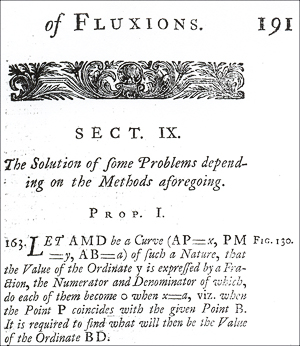
and Fig. 130.
L'Hospital on Leibniz
 L'Hospital on
Leibniz: L'Hospital on
Leibniz:
"I must here in justice own, (as
Mr. Leibnitz (sic) himself
has done in Journal des Scavans
for August, 1694) that the learned Sir Isaac Newton likewise discovered
something like the Calculus
Differentialis, as
appears by his excellent Principia,
published first in the year 1687 which almost wholly depends upon the
use of the said Calculus.
But the method of Mr. Leibnitz's
is much more easy and expeditious, on account of the notation he uses,
not to mention the wonderful assistance it affords on many occasions."
|
 Marquis de l'Hôspital
Marquis de l'Hôspital
(1661 - 1704)
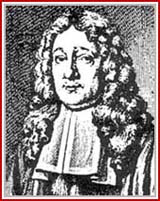
Johann van
Waveren Hudde
(1628 - 1704)
|
| Starting
with the study of tangents to curves, all of the men
represented on this web page made significant contributions to the
initial formulation of what today we call The Calculus. |
See the Acta Eruditorum of 1697.
|
|
|
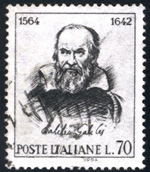
Galileo
Galilei
(1564-1642)

René Descartes
(1596 - 1650)

Pierre de Fermat
(1601 - 1665)

Blaise Pascal
(1623 - 1662)

Leibniz
(1646 - 1716)
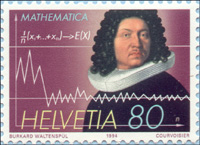
Jacob
Bernoulli
(1654 - 1705)
Editor of Acta Eruditorum
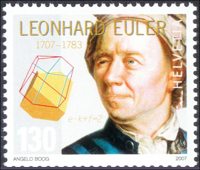
Leonhard Euler
(1707 - 1783)

Sir Isaac Newton

|
|
|
We find at least two famous disputes
in play when writing about this crucial chapter in the history of
mathematics. First, there is the legendary dispute over the priorty
between
Newton and Leibniz. Who grasped the basic concepts of calculus first?
To this controversy readers should also know Johann Bernoulli became
outraged when l'Hospital published Analyse with his
name as the sole author. Bernoulli had tutored l'Hospital over several
months both in Paris and in Basel on this topic. Thus Bernoulli felt
his ideas, particularly the explanations, were stolen.
Interestingly, viewers of this web page can see the cover page
(frontispiece) in the background. No name appears!
Moreover, no name appears in print throughout the entire volume.
Students always ask about the correct spelling of the name. We
prefer the usage of the 1730 translation - l'Hospital. (Use an
"L" at the beginning of a sentence.)
No matter what one's opinions on
priority and credit for scientific work, scholars agree that the Analyse is the
first textbook on differential calculus. Newton's work was in notebooks
or published late. Leibniz's six pages of propositions were too terse
to be
understood without great effort on the part of the most advanced
mathematicians. Thus, l'Hospital's Analyse with good examples spread over 181
pages of explanations was the
crucial elementary introduction for the calculus so needed to advance
mathematics. Moreover, in the preface he gave credit for prior
work on l'intelligence des lignes
courbes - curved lines, the genesis on our National Curve
Bank Project: A MATH Archive - to no less than the following
mathematicians:
Archimedes,
Viète, Descartes, Pappus, Pascal, Barrow, Leibniz, Newton, two
Bernoullis, Craig, Huygens, Tschirnhausen and Hudde.
Reading
the original source, the lasting impression is l'Hospital wrote a great
book and was more than willing to express his debt to others.
Shirley B. Gray, December 29, 2009
|
|
|
|
The Analyse des infiniment
(1696) images are reproduced
with permission of The
Huntington Library, San Marino, CA. Students of mathematics
are most grateful for the opportunity to view the original
sources.
The English translation (1730) of Analyse des infiniment
was prepared by E. Stone and printed by William Innys.
|